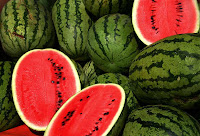 buy clomid over the internet Learning the way of the Watermelon
buy clomid over the internet Learning the way of the Watermelon
Watermelon season is ending in some parts of the U.S. but before it’s all over lets take this time to hone in on why watermelon is so beloved.
Meanwhile, my friend Tom takes Chi Quong classes and is rewarded with watermelon at the end of each session. Chi or Qi means “life force” or energy and Chi Quong is a physical training regimen meant to restore energy. One purported benefit of Chi Quong is that it improves back health by increasing blood flow to otherwise dehydrated muscles and discs adjacent to the spine. The post-Chi Quong watermelon may also enhance hydration.
Watermelon, living rightly by its name, is a very watery melon. It holds more water than any other fruit (92 percent water) which is perfect for rehydrating the body overall. It is the watery nature of this melon that also makes it a low glycemic food. The water content dilutes the amount of sugar per serving thereby causing a slower rise in blood sugar after consumption compared to other fruits. However, all fresh fruits and vegetables are “low glycemic” when compared to dry processed foods. Water rich foods are the foods that will help you achieve that coveted “six pack.”
One downfall of watermelon, aside from it causing a man to stab himself, is that it is not exceptionally high in most of the nutrients found in other fruits. Watermelon is, however, one of the few well known sources of a carotenoid called Lycopene. Lycopene brings blush to foods such as tomatoes, pink grapefruit, guava and, of course, watermelon.
Lycopene is one of the hundreds of identified antioxidants—disease fighting, free radical scavengers. It is especially protective in the liver, lungs, prostate gland, colon and skin, where the concentration of Lycopene tends to be higher than all other carotenoids.
Research shows that Lycopene is more bioavailable when its food sources are pureed or cooked. Some great sources of Lycopene include tomato soups, sauces, juices and organic catsup.
Lycopene is also a very stable antioxidant and does not significantly degrade when frozen. If you are trying to stock up on melon while it is still in season, here are a few helpful recipes so you can eat some now and freeze some for later. Hopefully you will restore your Chi and not stab yourself over a melon-eating mutt.
Westerly Halibut or other white fish:
2 (4 oz) pieces of white fish
Juice of one lime
1 tablespoon canola oil
1 clove garlic, minced
1/2 inch ginger, peeled & grated
1 teaspoon honey
1/4 teaspoon Cayenne
Wisk together marinade ingredients for fish. Pour into a shallow baking dish and coat both sides of fish with marinade. Cover and refrigerate for 1-2 hours. Bake at 400 degrees for 10 minutes per inch of thickness. Add five minutes if you wrap fish in parchment.
Spicy Watermelon Salad:
2 cups 1/2-inch cubes seedless watermelon
2 bell peppers, preferably assorted colors, cut into 1/2-inch squares
1 jalapeno, minced
1/4 cup olive oil
3 tablespoons rice vinegar
2 teaspoons honey
1/4 teaspoon Cayenne
1/4 teaspoon sea salt (to taste)
1/4 teaspoon fresh black pepper (to taste)
Wisk together oil, vinegar, honey, cayenne, salt and pepper. Toss with chopped watermelon and peppers. Spoon onto a plate and top with baked white fish.
Watermelon Pear Smoothies
Since watermelon is so watery, it is best to blend it with a fruit that adds more viscosity and enhanced sweetness when pureed. With your “leftover” melon, cut it into chunks, remove seeds and add to blender. For every two cups of melon, add one chopped pear. Pour into ice cube trays to freeze for later use. When ready to serve, place frozen cubes in a blender. Add water or a little pear nectar until reach desired consistency. Garnish with chopped fresh tarragon or mint leaves and a squeeze of fresh lime juice.
Lycopene Lunch
Juice of one lime
2 teaspoons Dijon mustard
1 teaspoon honey
1/3 cup olive oil
4 cups of mixed greens, your choice, such as arugula, endive, mache, baby romaine
2 cups (1/2-inch pieces) seeded watermelon
1 pink grapefruit, peeled, cut into
1/2 inch triangles
1/4 red onion cut into very thin slices
12 fresh mint leaves cut into ribbons
Whisk first three ingredients in small bowl to blend. Gradually add oil and whisk until well blended. Season dressing with salt and pepper.Toss salad greens with dressing to lightly coat. Divide among two plates. Top with watermelon, grapefruit pieces, onion slices and garnish with mint. Add steamed, cooled shrimp or fish for protein.
 buy clomid over the internet Learning the way of the Watermelon
buy clomid over the internet Learning the way of the Watermelon
One Comment
Comments are closed.